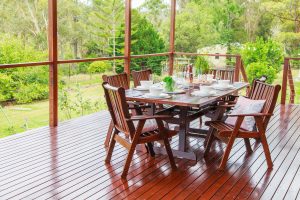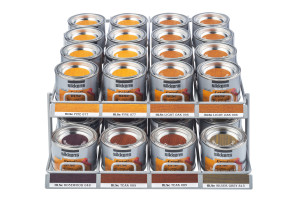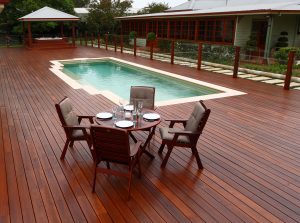There’s more to timber coating than colour
Spring is the perfect time to refresh and rejuvenate your timber decking. While regular sweeping and cleaning is valuable, a deck re-coat is recommended every 12 to 18 months to maintain the quality, durability and appearance of the timber. Timber is a porous material and therefore it is vital to protect the surface from dirt, grime, UV damage and moisture.
Navigating through an endless range of timber coatings and application methods can be a daunting experience for first time DIYers. The following tips will help homeowners choose the perfect finish.

Oil vs. water based coatings
Quality coatings save time and money in the long run, whether its oil or water based deck finish, each deck finish has its own benefits. Oil based deck coatings penetrate the wood better and are more durable however take longer to dry. An advantage of using an oil based coating is its transparency allowing for the natural characteristics of the timber to show through.
A water based coating is environmentally friendly and doesn’t produce as much odour during application or drying. Advantages to using water based coatings are faster drying time and easy clean up. With re-coating possible within two hours, the Sikkens Cetol BLX-Pro timber deck stain is perfect for a weekend project. Available in five ready mixed stain colours, its high quality, transparent finish accentuates the natural character and colour of the timber.
Do not mix water-based and oil-based coatings
It is recommended to stick with the most recently used deck coating type – whether oil or water based. Those looking to change between coating systems will need to completely strip the existing deck coating back to bare timber prior to re-coating which will ensure optimum adhesion

Deck stains
Look beyond in-store swatches when choosing colour. There are several factors to consider when selecting colour, including the deck’s location, exposure to weather and the natural variations of timber species. Coatings with darker pigments are better able to resist UV damage and therefore will require less maintenance, making them ideal for hotter climates and areas exposed to full sun.
Due to the natural colour and grain differences of various timber species, the final look of a coating can vary dramatically from deck to deck. Look for brands that offer sample pots, like Sikkens 100ml, as this is the best way to gain an accurate idea of the final colour.
Consider the function of the space
Different spaces require coatings that are relevant to their needs. For example a pool deck may require a specialty coating with inbuilt slip resistance, UV filters and extra moisture resistance. Sikkens Cetol Deck Slip Resistant has a textured finish ideal for around pools, stairs and walkways. Timber exposed to extreme heat and weathering, such as windows, doors, gates and fences, will benefit from coatings with added UV filters such as Sikkens Cetol Filter 7 Plus.As the sun comes out and temperature rises, it’s time to refresh and rejuvenate timber decking. While regular sweeping and cleaning is valuable, a deck re-coat is recommended every 12 to 18 months to maintain the quality, durability and appearance of the timber.
Importance of cleaning the deck
Ensure the timber is clean and free from dirt and grime to allow the new coating to properly penetrate and adhere to the timber for long lasting protection. For hardwood decks that are weathered or grey, a cleaning product such as Sikkens Cetol BL Deck & Wood Cleaner needs to be applied before recoating. This fast acting gel formula will brighten and revitalise grey and weathered timber, in preparation for application of the recoat.
